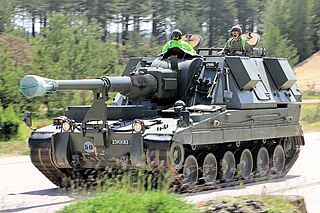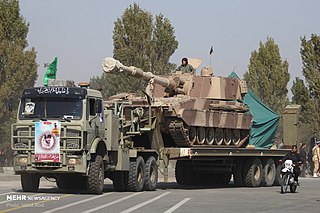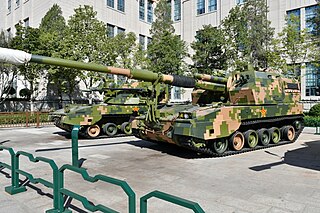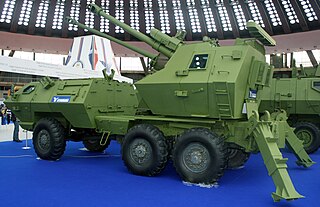Related Research Articles

The AS-90, known officially as Gun Equipment 155 mm L131, is an armoured self-propelled artillery used by the British Army.

The SU-122 was a Soviet self-propelled howitzer or assault gun used during World War II. The number "122" in the designation represents the caliber of the main armament, a 122 mm M-30S howitzer. The chassis was that of the T-34.

The 2S1 Gvozdika is a Soviet self-propelled howitzer introduced in 1972 and is in service in Russia and other countries as of 2024. It is based on the MT-LBu multi-purpose chassis, mounting a 122 mm 2A18 howitzer. "2S1" is its GRAU designation. An alternative Russian designation is SAU-122, but in the Russian Army it is commonly known as Gvozdika. The 2S1 is fully amphibious with very little preparation, and once afloat is propelled by its tracks. A variety of track widths are available to allow the 2S1 to operate in snow or swamp conditions. It is NBC protected and has infrared night-vision capability.

Raad-2 is an Iranian self-propelled howitzer.

Boragh or Boraq is an Iranian-made armoured personnel carrier. Boragh is believed to be a reverse engineered and upgraded model of the Chinese Type 86 (BMP-1). The upgrades include a reduction in weight, a higher road speed, and stronger armor. The vehicle is fully amphibious and is fitted with an NBC protection system and infra-red night vision equipment.

The 122-mm howitzer D-30 is a Soviet howitzer that first entered service in 1960. It is a robust piece that focuses on the essential features of a towed field gun suitable for all conditions. The D-30 has a maximum range of 15.4 km (9.6 mi) or 21.9 km (13.6 mi) using rocket-assisted projectile ammunition.

The DANA is a wheeled self-propelled artillery piece. It is also known as the Samohybná Kanónová Húfnica vzor 77. It was designed by Konštrukta Trenčín and built by ZTS Dubnica nad Váhom in the former Czechoslovakia. Introduced in the 1970s, it was the first wheeled 152 mm self-propelled artillery gun to enter service. It is based on a modified eight-wheel drive (8×8) Tatra 815 chassis with excellent cross-country mobility.

The SO-152, usually known by its GRAU designation 2S3, is a Soviet 152.4 mm self-propelled gun developed in 1968, as a response to the American 155 mm M109 howitzer. Development began in 1967, according to the Resolution of the Council of Ministers of the Soviet Union from July 4, 1967. In 1968, the SO-152 was completed and in 1971 entered service. The fighting vehicle also received the added designation Akatsiya (Акация), which is Russian for Acacia.

The Serbian Army is the land-based and the largest component of the Serbian Armed Forces.

The Type 89 self-propelled howitzer is a 122 mm self-propelled howitzer used by China's People's Liberation Army to replace Type 85 and Type 70 122 mm self-propelled howitzer. The PLZ-89 was first unveiled to the public during the 1999 Chinese National Day Parade.

The PLZ-05 or the Type 05 is a 155 mm self-propelled howitzer developed by the People's Liberation Army of China to replace the Type 59-1 130 mm towed gun and Type 83 152 mm self-propelled gun. The PLZ-05 was officially unveiled at the Military Museum of the Chinese People's Revolution to mark the 80th anniversary of the PLA in July 2007, and first entered service with the PLA in 2008.

The 51st Guards Artillery Brigade is an artillery brigade of the Belarusian Ground Forces, based at Osipovichi.

The PLZ-07 or Type 07 is a Chinese 122 mm self-propelled artillery made by the China North Industries Group Corporation (NORINCO). The PLZ-07 self-propelled howitzer was first unveiled to the public during the military parade celebrating 60th anniversary of the PLA on 1 October 2009. The PLZ-07 was developed to replace the older Type 89, Type 85 and Type 70/70-1 122 mm self-propelled artillery systems.
The full structure of the Polish Land Forces is:

SOKO SP RR is a truck-mounted self-propelled howitzer developed by Serbian arms manufacturer Yugoimport. It is based on integration of 122 mm 35-calibre D-30 J howitzer with a six-wheel drive truck chassis. It has a firing range of 21 kilometres (13 mi), and rate of fire of 6 rounds per minute.
The 2S15 Norov is a Soviet self-propelled gun based on the 2S1 Gvozdika, itself based on the MT-LBu chassis. The 2S15 was not mass-produced.
The 15th Guards Mozyr Red Banner Order of Suvorov Tank Division was a tank division of the Soviet Army during the Cold War that became part of the Russian Ground Forces after the dissolution of the Soviet Union.
References
- 1 2 3 Galen Wright 2011) Iranian Military Capability 2011 – Ground Forces
- ↑ "Thunder 1".
- ↑ Stijn Mitzer; Joost Oliemans (October 6, 2022). "The Oryx Handbook Of Iranian Fighting Vehicles".
- ↑ "Thunder-1 gun, 122mm, self-propelled, tracked". www.jedsite.info. Archived from the original on 7 February 2008. Retrieved 12 January 2022.